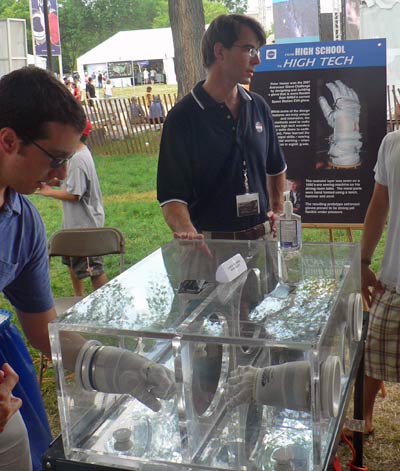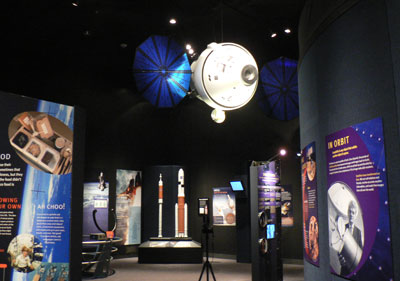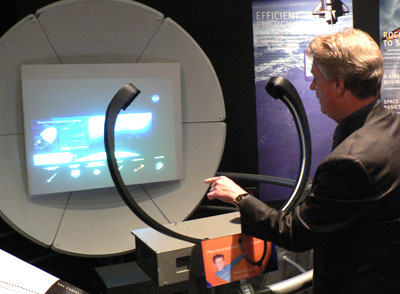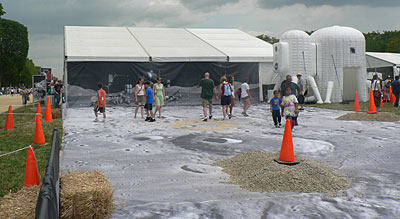Review: Space on the Mallby Jeff Foust
|
 Peter Homer shows off the latest versions of his astronaut glove that won a NASA Centennial Challenges competition. (credit: J. Foust) |
The exhibition is, in many respects, more a look ahead at what NASA plans to do in the years to come rather than what it has done in the last 50 years. Elements of the exploration program are front and center, including a model of the Ares 1 rocket and a mock lunar landscape that people can walk on and get their pictures taken with. Meanwhile, shunted away in a corner, almost hidden from view from the rest of the exhibition (although in plain sight to passing traffic on 14th Street), was an inflatable model of the Space Shuttle, sagging slightly.
If you can’t make it to the Folklife Festival (or if you’re not that enthusiastic about the idea of trekking across the Mall in near-tropical weather) the nearby National Air and Space Museum recently opened a temporary exhibition, “Space: A Journey to Our Future”. The exhibit is actually a version of a traveling exhibition that has been making the rounds the last couple of years, including museums in Indianapolis, Omaha, and Mexico City. (Museum officials said at a press event earlier this month that they had hoped to keep the exhibit open a little longer in January to accommodate people coming to Washington for the presidential inauguration, but the exhibit needs to be shipped to its next destination, Sacramento.)
 The “Space: A Journey to Our Future” includes Ares and Orion models on display. (credit: J. Foust) |
As the title suggests, the exhibit is primarily forward-looking, examining how humans will return to the Moon and go on to Mars and elsewhere in the solar system. The exhibit is crammed into a relatively tight area on the far eastern end of the museum’s lower level, near the food court, which doesn’t give it a lot of, well, space. There’s little in the way of historical artifacts in the exhibit (the rest of the museum, of course, more than makes up for this); instead there’s a walk-though model of what a lunar habitat might be like, and models of Orion and the Ares 1 and 5 (which were due to be replaced with a larger model of just the Ares 1 shortly after the exhibit opened in mid-June.) A miniature theater provides 360-degree video projections of a brief film about astronomy.
The exhibit does put an emphasis on interactivity, with mixed results. One display invites people to put together the cargo needed for a human mission to Mars from a list of items, given the limited capacity of the spacecraft (a hint: make sure to bring food and water, but also don’t forget a little entertainment.) Another offers people the opportunity build an Ares rocket by dragging and dropping components in the right place. However, this exhibit eschews tried-and-true touch screens for a high-tech approach where you waive your hand in the vicinity of a sensor that looks like a giant upside-down pair of headphones (or a sci-fi movie prop). The system was suffering some glitches during a pre-opening walkthrough; it also leaves one to wonder how it will work when, say, a crowd of kids tries to stick their hands into it at the same time.
 Roger Launius of the National Air and Space Museum demonstrates—or at least tries to—an exhibit where people use an unusual interface to assemble a rocket model. (credit: J. Foust) |
Neither the Folklife Festival nor the “Space: A Journey to Our Future” exhibit is worth a special trip to Washington; the latter is particularly underwhelming for enthusiasts, although that is in large part because it’s targeted at more general, and also to some degree younger, audiences. Both, though, demonstrate that even as NASA marks its 50th year of existence, it is trying hard to put its focus on its potential future, not its past.
